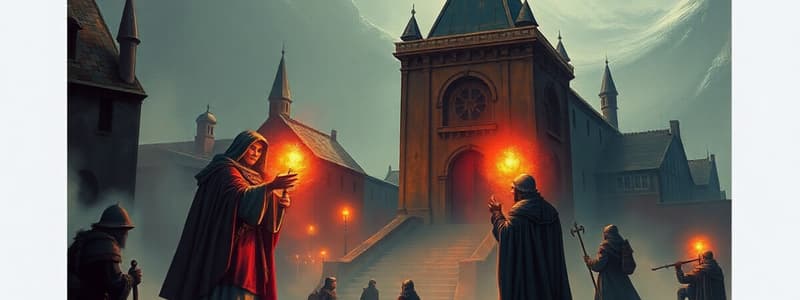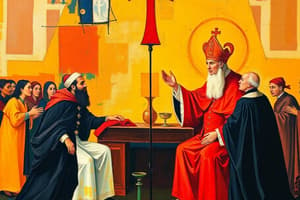Podcast
Questions and Answers
What is the primary effect of the Black Death on the economy of Europe?
What is the primary effect of the Black Death on the economy of Europe?
- The Black Death resulted in an increase in the value of currency and a decrease in trade.
- The Black Death led to a decline in trade, an increase in laborers' wages, and a drop in food costs. (correct)
- The Black Death had a significant impact on social structures, resulting in a shift towards feudalism.
- The Black Death led to an increase in the cost of living and a decrease in wages
What was the primary reason for the Great Schism?
What was the primary reason for the Great Schism?
- The Great Schism arose from the plague, causing people to question the authority of the Church.
- The Great Schism was caused by a conflict between the French and English monarchs.
- The Great Schism was caused by disputes over the power of the clergy.
- The Great Schism was the result of two or even three competing claimants to the papacy. (correct)
Which of these is NOT a consequence of the Black Death?
Which of these is NOT a consequence of the Black Death?
- Growing power of the Church. (correct)
- Increased independence for peasants.
- Increased serfdom.
- Weakened feudalism.
How did the Black Death contribute to the weakening of the feudal system?
How did the Black Death contribute to the weakening of the feudal system?
What was the primary motivation for the reform leaders like John Wycliffe and Jan Hus?
What was the primary motivation for the reform leaders like John Wycliffe and Jan Hus?
What is the main reason for the Hundred Years' War?
What is the main reason for the Hundred Years' War?
What was the primary effect of the Great Schism on Western Europe?
What was the primary effect of the Great Schism on Western Europe?
What is the most likely reason for the presence of skeletons collecting the bodies of the dead in the painting?
What is the most likely reason for the presence of skeletons collecting the bodies of the dead in the painting?
Flashcards
The Black Death
The Black Death
A devastating plague that struck Europe in the 14th century, leading to massive population decline.
Effects on Economy
Effects on Economy
The Black Death caused a decline in trade, rising wages due to labor shortages, and falling food prices.
Weakening of Feudalism
Weakening of Feudalism
The Black Death contributed to the decline of feudalism as serfs gained more rights and began paying rent.
Great Schism
Great Schism
Signup and view all the flashcards
Council of Constance
Council of Constance
Signup and view all the flashcards
Criticism of the Clergy
Criticism of the Clergy
Signup and view all the flashcards
John Wycliffe
John Wycliffe
Signup and view all the flashcards
Hundred Years' War
Hundred Years' War
Signup and view all the flashcards
Study Notes
Divisions in Religion and Politics
- The bubonic plague, along with disputes in the Church, impacted Late Middle Ages Europe
- Conflicts between English and French kings over territory occurred, resulting in the Hundred Years' War
- Christian kingdoms in the Iberian Peninsula fought to drive out Muslims
- The Great Schism (1378-1417) caused divisions in the Church, with multiple claimants to the papacy.
- A council of bishops met in Constance, resolving the Schism in 1417
Conflict in the Church
- Church authority was challenged by powerful European kings
- The kings of England and France challenged papal authority
- Many people criticized the increasing wealth and corruption of the clergy
- Reformers like John Wycliffe in England and Jan Hus in the Holy Roman Empire advocated for a more spiritual form of Christianity
The Effects of the Plague
- The Black Death's cause was unknown at the time
- Some blamed God, others directed blame at the Jewish community.
- The plague's widespread death led to economic shifts:
- Trade declined due to labor shortages
- Wages increased as a result of high demand for workers
- Food prices dropped due to decreased demand
The Hundred Years' War (1346-1453)
- The Hundred Years' War was a series of conflicts between England and France
- Fought primarily in French territory
- Marked a significant development of national feeling in both countries
Studying That Suits You
Use AI to generate personalized quizzes and flashcards to suit your learning preferences.





